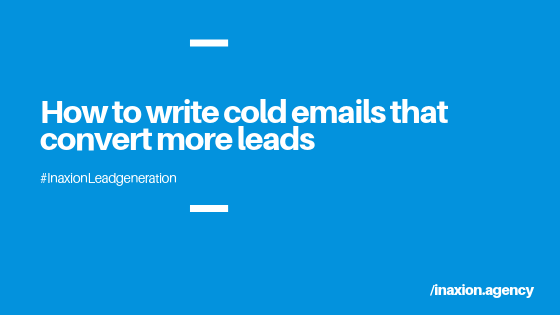On average we receive 120 work related emails per day. No wonder so few of us are able to reach inbox zero.
Not sure how to write cold email copy that closes sales? Imagine someone getting a cold email from you. Why would they open it? They don’t know who you are, where you work or how you could possibly add value to your day. Can they even trust that you’re who you say you are?
I’m not saying that you should abandon emailing prospective customers, rather the opposite. Email remains one of the best ways to communicate and interact with your audience and prospects. I’ll outline 8 steps to follow in order to update your cold email approach to convert more emails into sales.
Identify your ideal client
This will seem quite obvious however, it’s often overlooked. If you’re selling ice cream machines you should be targeting restaurants and ice cream trucks, not book stores and gyms. In other words, only target people or organizations that will benefit from your product or service.
Once you’ve identified your target audience, look for the right person to reach out to. This should be a decision maker that will be able to decide whether their company will use your product or service. If you can’t connect with that person, look for a referral who can introduce you to the main decision maker.
This sounds tedious but LinkedIn has made this process much easier than it has been in the past. Using the search filter you can search with multiple field selected. For instance, McDonald’s; vice-president restaurant operations. This will help you find the relevant contact to reach out to.
Target your prospects pain points
Once you’ve identified the organization and decision maker, put yourself in their shoes and think about what keeps them up at night, what their pain points and hot button issues are. For example, if you offer cybersecurity services and you saw that a large bank had recently had a data leak due to a hack, this would be a problem you could help with.
Get their email
Now you’re ready to go out and get those emails. Be active on LinkedIn and send connections to your prospects in order to warm the cold outreach. Don’t be afraid to connect with multiple people at one company. Once you’ve connected you’ll be able to see the persons contact details.
Use the right subject line
Most people are focused on crafting the perfect email body when they’re forgetting about the subject line. Without a compelling subject line, your prospect will never read the email you took so long to write.
If you haven’t already, go a head a read out post about the four subject line strategies that earn $7 million in revenue.
Be concise
With people receiving so many emails per day, you only have a few minutes to make an impression and generate a reply. In order to get what you want out of the email be brief, be direct and be clear. After a few sentences of reading your email the prospect should already have an understanding of its context.
You can avoid the pleasantries. The person you’re email why you’re emailing and how they can benefit from what you’re pitching.
Don’t be afraid to add some social proof at the end of your email. If you helped a client increase their sales by 30%, don’t be afraid to include that in your email.
Use personalization
Research has shown that personalized emails receive a 17% reply rate compared to generic emails which only saw 7% reply rate.
Personalization doesn’t have to be complex. You just need to stick to the basics: the person’s name and company name. This shows initiative and that you did your research on the prospect.
Use one call to action
If you’re looking to increase your chances of a conversion, you’ll need to ask your prospect a question. This is best done in a clear call to action. Put simply, the steps you want to person to take after reading your email.
You’ll have to customize your call to action based on what you’d like the person to do however, I’ve found the most success by asking if they’re free for a discovery call at a specific time.
“Are you free for a call Wednesday at 2 pm to discuss further?”
I’ve found that when you give someone a specific date and time it’s easier for them to decide yes or no. If you complicate it by asking them what time they’re free it adds an extra layer of complexity and leads to a lower conversion rate.
Always follow up
When you’re focused on volume it’s easy to forget to forget to follow up but time and time again, research has shown that most people reply to a cold email after 4-5 follow ups. If someone doesn’t reply to your initial email it doesn’t necessarily mean they aren’t interested.
Following up with a gentle reminder is a great way to show your prospect that you’re persuasive and care about their business.
InboxBrain is a great tool to use to automate the process entirely so you can focus on prospecting and closing more sales.
A/B test your emails
Email is an ongoing process. Meaning you’ll need to test and optimize your email creative. Doing this will increase your open and reply rates.
Use InboxBrain to track email opens and test different subject lines as well as email copy to track the best engagement. By split testing different subject line and email body combinations you will be able to reach your optimum open and reply rate to convert more sales from cold emails.

